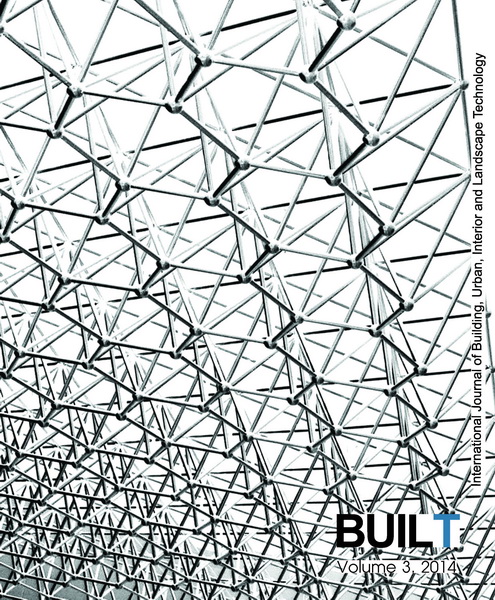Development and Performance Evaluation of a Steady-State Virtual Sensor for Predicting Wall Surface Temperature in Light Commercial Buildings with an Open Space
Keywords:
MLR, Retail stores, RTUs, Virtual sensor, Supervisory controlAbstract
Multi-zone layout is commonly designed for low-rise cubicle offices or big-box retail stores. These buildings are served by multiple rooftop units (RTUs) to supply heating and cooling. Regarding this open space layout without interior walls between zones, heat balance effect between a zone and adjacent zones is occurred rather than general multi-zones with interior walls. This effect probably causes simultaneous cooling and heating or cooling fighting because each RTU has individual and uncoordinated control resulting in excessive energy use and shorter cycling operations of RTUs. To measure this effect and solve the problem, this article proposes a virtual sensor for predicting wall surface temperature by using a steady-state equation based on multiple linear regressions (MLR). Utilizing rich data of practical operations obtained from the simulation of multiple RTUs, MLR can be used to accurately extrapolate within the range of the training data. Using the building simulation platform based on heat, air and Moisture laboratory (Hamlab) without RTU operations, this simulated data are used to validate the developed model. To further evaluate the model performance, the three control modes of the multiple RTUs including undersized, right-sized and oversized capacities of multiple RTUs are simulated and studied. The results show that the proposed virtual sensor improves the implementation performances of dynamic virtual wall surface temperature sensor under off-control conditions around 16 to 20% based on goodness of fit (G). In addition, the proposed method can be applied as a tool in predicting wall surface temperatures of special cooling and heating wall in renewable energy areas.
Downloads
References
Aranda, A., Ferreira, G., Mainar-Toledo, M. D., Scarpellini, S. & Sastresa, E. L. (2012). Multiple regression models to predict the annual energy consumption in the Spanish banking sector. Energy and Buildings, 49, 380-387.
Asuero, A. G., Sayago, A. & Gonzalez, A. G. (2006). The correlation coefficient: An overview. Critical Reviews in Analytical Chemistry, 36, 41–59.
American Society of Heating, Refrigeration and Air- Conditioning Engineering. (2009). ASHARE Handbook – Fundamentals. Atlanta, GA: Author.
Bonne, D. & Jorgensen, S. B. (2004). Data-driven modeling of batch processes. Proceedings of 7th International Symposium on Advanced Control of Chemical Processes (ADCHEM)January. Hong Kong, China.
Catalina, T., Virgone, J. & Blanco, E. (2008) Development and validation of regression models to predict monthly heating demand for residential buildings. Energy and Buildings, 40(10), 1825–1832.
DOE. (2011). Energy Information Administration (EIA), Annual Energy Outlook. USA: Author.
Djunaedy, E., Wymelenberg, K. V. D., Acker, B. & Thimmanna, H. (2011). Oversizing of HVAC system: signatures and penalties. Energy and Buildings, 43(2-3), 468-475.
Felts, D. R. & Bailey, P. (2000). The State of Affairs - Pack aged cooling equipment in California. Proceedings of the 2000 ACEEE summer study on energy efficiency in buildings. California, Washington, DC.
Hair, L., Anderson, R. E., Tatham, R. L. & Black, W.C. (1995). Multivariate data analysis (4th ed.). New Jersey: Prentice-Hall Inc.
James, S., Legge, R. & Budman, H. (2002). Comparative study of black-box and hybrid estimation methods in fed-batch fermentation. Journal of Process Control, 12(1),113–121.
Katipamula, S., Reddy, T. A. & Claridege, D. E. (1998). Multi variate regression modeling. Journal of Solar Energy Engineering, 120(3), 177-184.
Lam, J. C., Wan, K. K. W, Liu, D. & Tsang, C. L. (2010). Multiple regression models for energy use in air- conditioned office buildings in different climates. Energy Conversion and Management, 51(12), 2692–2697.
Li, H. & Braun, J. E. (2007a). Decoupling features and virtual sensors for diagnosis of faults in vapor compression air conditioners. International Jounal of Refrigeration, 30(3), 546-564.
Li, H. & Braun J. E. (2007b). A methodology for diagnosing multiple-simultaneous faults in vapor compression air conditioners. HVAC&Research, 13(2), 369–395.
Li, H., Yu, D. & Braun, J. E. (2011). A review of virtual sensing technology and application in building system. HVAC&R Research, 17(5), 619–645.
Niu, F., Yu, Y. & Woradechjumroen, D. (2014). Investigation of an active tuning building envelop based on capillary network. International Conference on Sustainable Design, Engineering and Construction (ICSDEC), China.
Reddy, T. A. (2006). Evaluation and assessment of fault detection and diagnostic methods for centrifugal chillers—Phase II.: GA Final project report of ASHRAE Research Project RP-1275, June. GA: Atlanta.
Rivers, N. (n.d.). Management of energy usage in supermar ket refrigeration systems (Session 2004-2005). Carshalton, Surrey: The Institute of Refrigeration.
Schijndel, A. W. M. van (2007). Integrated heat air and moisture modeling and simulation. Eindhoven: Technische University Eindhoven.
Woradechjumroen, D., Yu, Y., Li, H., Yang, H. & Yu, D. (2014). Analysis of HVAC system oversizing in commercial buildings through field measurements. Energy and Buildings, 69, 131–143.
Wilcox, S. & Mario, W. (2008). Users manual for TMY 3 data sets (Technical Report NREL TP–581-4356, May 2008). Colorado: National Renewable Energy Laboratory.
Yang, H., Xu, Z., Xiong, R., Li, H., Zhang, T.C., Liu, X. & Woradechjumroen, D. (2014 ). Simplifying manu facturers’ data in unitary HVAC equipment through a DX cooling coil modeling. Energy and Buildings 74, 152-162.
Yu, Y., Woradechjumroen, D. & Yu, D. (2014). Virtual surface temperature sensor for multi-zone commercial buildings. The 6th International Conference on Applied Energy, Taipei City. Taiwan, China.
Downloads
Published
How to Cite
Issue
Section
License
Copyright (c) 2014 International Journal of Building, Urban, Interior and Landscape Technology (BUILT)

This work is licensed under a Creative Commons Attribution-NonCommercial-NoDerivatives 4.0 International License.












